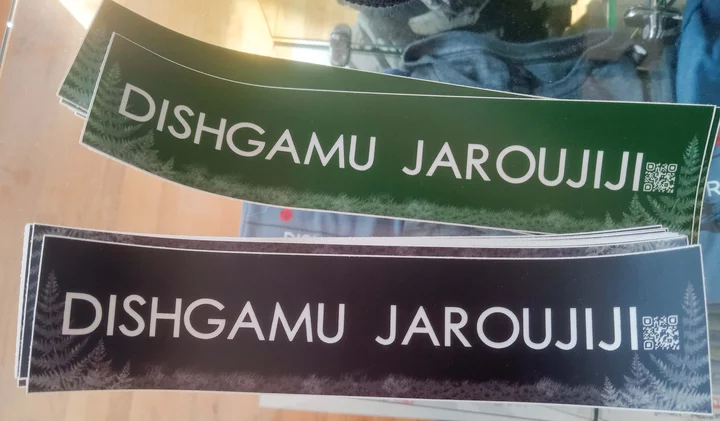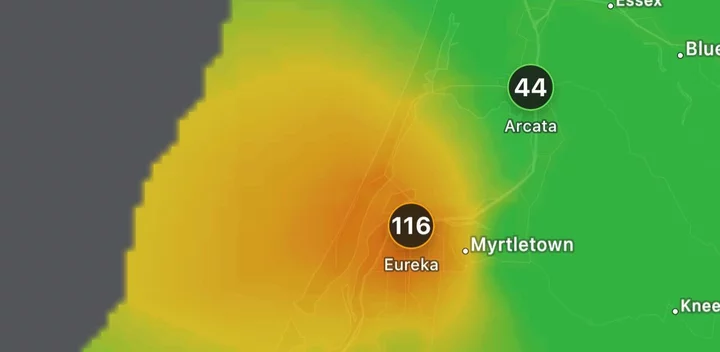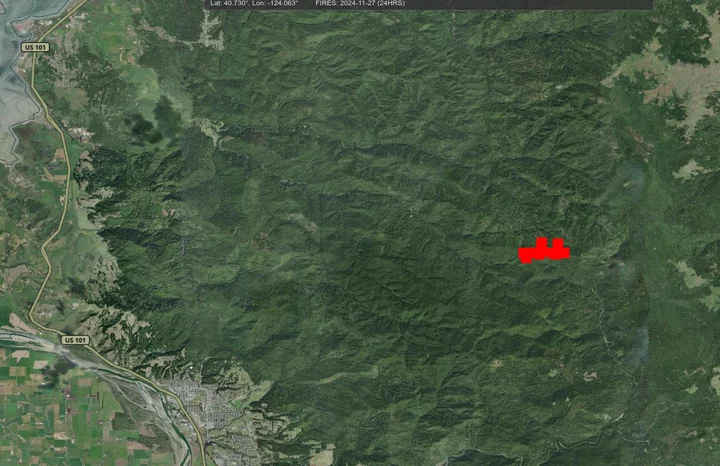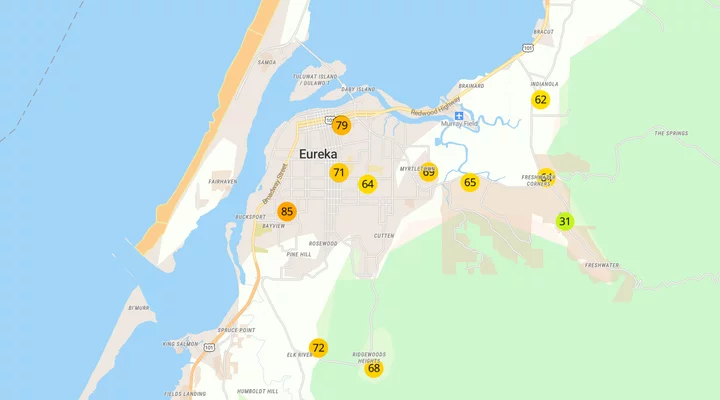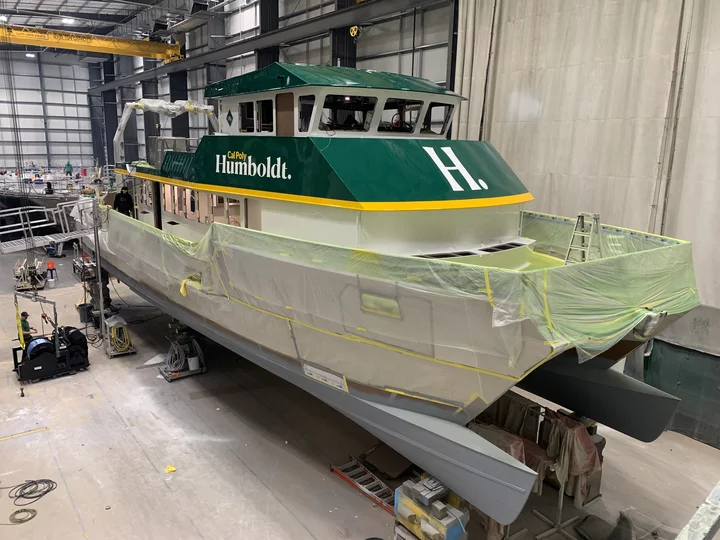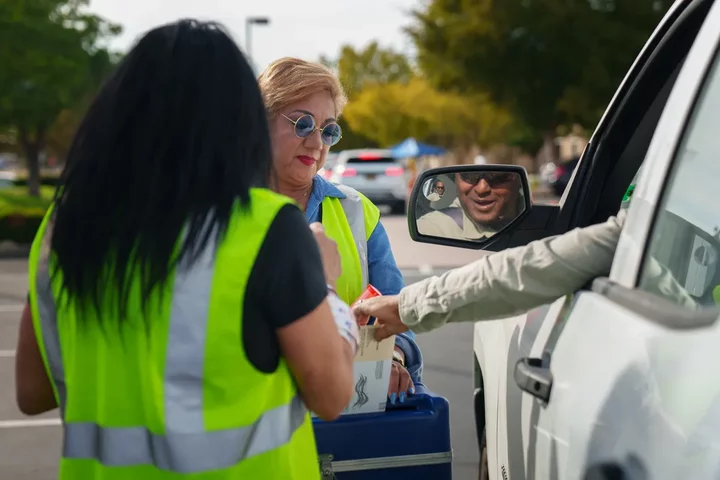What’s in a Name? Inside the Wiyot Tribe’s New Program to Find Soulatluk Names for Local Places
Dezmond Remington / Wednesday, Nov. 27, 2024 @ 1:09 p.m. / Tribes
“I like Eureka” in the Soulatluk language.
Last week, readers of the Outpost may have noticed that a bridge in Fieldbrook was renamed to a word in the Wiyot language, Soulatluk. Turns out, that’s not a one-off event — the Wiyot Tribe runs an as-yet unnamed program that names or renames some places they agree needs a touch-up.
If someone has a place they’d like named or renamed, they pitch it to Ben Brown, the director of the Wiyot Tribe’s cultural department. Brown takes it to a committee, and if they think it’s worthy of a name, it goes before the Wiyot Tribal Council for final approval. Then it gets kicked to the tribe’s linguists.
Some places have historical Soulatluk names that the linguists can find in Wiyot ethnographies, like the 1918 Ethnography and Archaeology of the Wiyot Territory by L.L. Loud. Other places require a little more creativity. Researchers look for historical activities that took place in the area, or what kind of flora and fauna live there.
“There was recently a Marine Protected Area [who] were redoing their signage,” Brown said. “They wanted a place name for their area in Samoa, and the cultural committee came up with the word — basically, [it translates to] ‘Across the bay, in a place where people used to live,’ or something like that. That’s Soulatluk; it’s not usually, like, valhuk equals ‘salmon,’ it means ‘feasting food,’ and Western society defines it as salmon, and that’s not generally how they approach defining their Soulatluk. It’s descriptive.”
New names are purposefully vague to avoid tempting potential grave diggers or artifact stealers.
So far, the cultural committee has named or renamed about six different places in the four months since the project began. They’re unlikely to run out of work any time soon, though; Brown says the backlog of requests is long, and the process requires at least three to four months.
The services rendered by the tribe aren’t free. The cultural committee charges $100 an hour, and if someone wants a sign in Soulatluk, the committee in charge of that runs $400 an hour total. The Fieldbrook bridge renaming only ran the Humboldt County Board of Supervisors $200, but that process was simple because a historic Soulatluk name for Fieldbrook already existed.
The program’s ideal candidate is a place with an offensive name, like the recently renamed bridge in Fieldbrook. Others are places named after colonizers.
“There’s a lot of power in language,” Brown said. “When you have places named after all of these mass murderers, they were celebrated in the past, but we’re revisiting that history and seeing these people with our modern eyes.”
Brown specifically mentioned the locality of Larabee, a mile from Redcrest — a town named after a man who killed Native Americans during the 1860 Tuluwat Island Massacre.
“That needs to change,” Brown said. “We can’t celebrate these people from that part of history. We know that history has dark and difficult parts to it. But the way to combat that is to bring it into the light … It’s like in Nazi Germany; they didn’t try to sweep it under the rug. There’s memorials for what took place. And as a country, they accepted their role and made amends. They continue to learn from it and move forward. And that’s the exact same thing that needs to take place here — recognize what happened in the past and do whatever we can to make it right.”
BOOKED
Today: 9 felonies, 10 misdemeanors, 0 infractions
JUDGED
Humboldt County Superior Court Calendar: Today
CHP REPORTS
9124 Mm101 N Men T91.20 (HM office): Assist CT with Maintenance
3500 Mm101 N Hum 35.00 (HM office): Assist with Construction
ELSEWHERE
RHBB: California Deer Season is in Full Swing
RHBB: As school begins, First Partner joins State Parks in promoting free passes, educational programs
RHBB: Life Plan Humboldt Unveils Humboldt Commons, a National Model for Community-Based Aging
Governor’s Office: Governor Newsom pre-deploys additional resources to Southern California ahead of heat and red flag warnings
(UPDATE) What Was Up With That Smoke Warning in Eureka Earlier Today?
Hank Sims / Wednesday, Nov. 27, 2024 @ 12:11 p.m. / Emergencies
UPDATE, 1:52 p.m.: Brian Wilson, pollution control officer with the North Coast Unified Air Quality Management District, gets back to tell us that our original hypothesis was most likely correct — that the smoke warning was probably due to wood stoves firing up across the town.
The slash pile burn up near Headwaters Forest that we write about below — and which Wilson confirmed — couldn’t have contributed much to the smoke given weather patterns at the time, he said.
Wilson added that the private weather/smoke apps like PurpleAir or the built-in iPhone weather app generally average their air quality numbers over a very short period of time — 10 minutes, say. So while people with conditions like COPD might indeed feel the smoke, it’s unlikely to have immediate, serious health consequences. The governmental standard is to average those numbers over 24 hours.
###
ORIGINAL POST:
Screenshot of bad air from the iPhone weather app as of early this morning.
Earlier this morning, many people were warned, via their various weather apps, that the air quality in Eureka today was extremely poor — up into the “unhealthy for sensitive groups” category.
Why would that be?
Our first thought was that perhaps this was just an effect of people firing up their wood stoves for the crisp weather last night. Perhaps some of those wood stoves were close to air quality sensors. It didn’t seem particularly smoky, to our noses.
But then looking around at some of our usual fire resources, we see that a couple of the usual satellites did detect a pretty wide set of hotspots on the ground up in the hills between Headwaters Forest and Kneeland, near logging roads. That’s Humboldt Redwood Company land.
Screenshot from of VIIRS fire activity detection data from NASA’s FIRMS website.
These hotspots were detected in the middle of the night, which seems like a strange time for a prescribed burn, or the burning of this year’s logging slash.
But that’s what we must suppose it to be. That’s what Calfire Division Chief Paul Savona supposed it to be, when we reached him a few moments ago. Calfire has not responded to any wildfire incidents in a while.
Reached at their Scotia headquarters, the person who answered the phone for Humboldt Redwood Company said that anyone who would be able to answer the question was already out of the office for the holidays.
We’ve left messages with the North Coast Unified Air Quality Management District — the agency that would be in charge of large-scale burn permits at this time of year — but haven’t heard back yet.
Did these Elk River fires contribute to our poor quality this morning? Seems likely, though I suppose we still can’t say for sure. In any case, the smoke seems to have died down. Apps like PurpleAir currently show us in the “acceptable” range for particulate matter. Mostly.
We’ll update if we hear back from Air Quality.
PurpleAir map as of noon.
Two Arrested for Stealing Fencing From Someone’s Private Property in McKinleyville
LoCO Staff / Wednesday, Nov. 27, 2024 @ 10:07 a.m. / Crime
Lindsey Kauffman (left) and Aaron Gamble | Booking photos.
###
Press release from the Humboldt County Sheriff’s Office:
On Nov. 16 at about 9 a.m., Humboldt County Sheriff’s deputies were dispatched to a call for service regarding theft of fencing from a private property on Central Ave. in McKinleyville.
A concerned citizen reported to the Sheriff’s Office dispatch center that they observed a male and female stealing the fencing from the property and placing it into a tan pickup truck on Nov. 16. Security video footage from a nearby home corroborated the witness statement. Deputies responded to the scene of the theft and contacted the victim. The deputies confirmed that the theft was greater than $950, and a felony theft investigative report was taken.
Based upon the witness statement and the video evidence, deputies followed up on this investigation by searching various locations in McKinleyville. The deputies subsequently located the suspect’s vehicle at a private residence. The two suspects caught in the video were contacted and apprehended on scene without incident. The stolen property was recovered and returned to the owner.
Aaron Gamble, age 39, of McKinleyville, and Lindsey Kauffman, age 39, of McKinleyville, were booked into the Humboldt County Correctional Facility around 12:15 p.m. on Nov. 16 for Grand Theft (PC487(a)) and Conspiracy to Commit Crime (PC182(a)(1)). Kauffman had an additional charge for Probation Violation (PC 1203.2(a)(2)).
This case is still under investigation.
Anyone with information about this case or related criminal activity is encouraged to call the Humboldt County Sheriff’s Office at (707) 445-7251 or the Sheriff’s Office Crime Tip line at (707) 268-2539.
(VIDEO) EVEN MORE BRETT: ‘Humboldt’ Songwriter’s Latest Splashy Music Video Celebrates the Fall and Rise of the Klamath River
Andrew Goff / Wednesday, Nov. 27, 2024 @ 10 a.m. / Our Culture
As we head into the Humboldt holidays, there is plenty to give thanks for. For one, we seem to have more Brett McFarland music videos than we know what to do with! Our cup truly runneth over.
Speaking of runneth, that is something the Klamath River is doing again after the completion this year of the removal of several dams that have long impeded its flow. To mark these historic events, the latest high-budget McFarland clip — for the song “Klamath” — celebrates the tireless efforts of local tribes to remove the dams in the hopes that salmon runs would return to their historic levels.
Watch the video above, and read more about the inspiration for the song in the release from McFarland’s camp below:
Northern California Tribes have collaborated with local farmer, Brett McFarland, to release a new music video celebrating the historic undamming of the Klamath river. The video, Klamath, tells the powerful story of the river’s demise and the multi-tribe led effort to un-dam and restore what was once the third largest salmon producing river in the continental US.
This video comes just months after the last of the four dams were removed on the Klamath to reopen more than 400 miles of fish habitat. For the first time in over a century, salmon are returning to Oregon to spawn. The sheer numbers of fish have exceeded fisheries biologists’ expectations. For the Yurok, Karuk, Hoopa, Klamath and Shasta tribes the homecoming represents the culmination of a decades long battle. “We’ve been fighting for dam removal for over twenty years and the day has finally come,” says Annelia Hillman, Yurok Tribal member, community organizer and river advocate.
The undamming of the Klamath marks the largest dam removal in world history and was made possible by people working together across cultural, state, and party lines to do what was right for the planet. The music video for Klamath celebrates this historic achievement and aims to inspire others.
PREVIOUSLY:
Cal Poly Humboldt Has Chosen a Name for Its New Science Ship
LoCO Staff / Wednesday, Nov. 27, 2024 @ 9:53 a.m. / Cal Poly Humboldt
The R/V North Wind will arrive in early 2025. Photo courtesy of All American Marine.
Press release from Cal Poly Humboldt:
The University’s new research vessel now has a name — the R/V North Wind.
The vessel’s name refers to the physical process that defines this region, driving the Pacific current, and contributing to ocean upwelling which provides the mild climate and rich fisheries along the North Coast. It drives the ocean swells that generate the rugged coastline and provides a steady stream of storms and moisture that leads to the temperate, wet climate that feeds the forests and grasslands.
The name was chosen as part of a collaborative process. In late October, the College of Natural Resources & Sciences launched a broad community survey with nine proposed names for the new research vessel. Nearly 2,000 students, staff, alumni, and community members responded to the survey, supplying 5,190 votes.
Thanks to this feedback, and in consultation with Tribal organizations, the R/V North Wind was chosen from the selection of name proposals. The name celebrates the region and speaks to the University’s strengths in the natural resources and sciences. It meets U.S. Coast Guard and general maritime industry standards and has been approved by the University Space & Facilities Advisory Committee in addition to the president.
The vessel will continue the University’s legacy of hands-on learning, supporting undergraduate and graduate marine research. It is set to arrive in February 2025.
“The R/V North Wind will expand our reach and capabilities in research and teaching throughout the North Coast,” Eric Riggs, Dean of the College of Natural Resources & Sciences said. “The new vessel adds capacity for addressing modern marine science, conservation, and economic issues that are directly relevant to communities and agencies in our region. It allows the University to be a full partner in the economic and scientific future of the offshore Blue Economy and allows our students to gain applicable skills and experiences in this growing area.”
The $8.5 million new research vessel is made possible by the state’s historic investment in Humboldt’s expansion as a polytechnic university.
The 78-foot-by-28-foot custom-built aluminum catamaran will travel at speeds up to 24 knots and can carry up to 40 students, faculty, and crew on research voyages. The vessel is equipped with a lab, a pilot house, diving platforms, and a variety of machinery for handling equipment and instrumentation. The lab and pilot house will carry state-of-the-art navigation and oceanographic electronics to measure the physical and biological features of the ocean floor and water column.
Research will continue aboard the University’s previous vessel, the R/V Coral Sea, until it is phased out for retirement from Cal Poly Humboldt by 2026 when the state’s new emissions standards take effect. The new emissions standards would require all of the vessel’s five engines to be replaced to operate in California. Though it has been well maintained, it is 50 years old and has far exceeded the average 30-year lifespan of a research vessel. For decades, the Coral Sea has supported undergraduate and graduate educational programs, allowing thousands of students to learn the basics of seamanship while also gathering and analyzing data on everything from fish to sediment.
Part lab, part floating classroom, the North Wind will advance the University’s ability to prepare students and train the next generation of marine scientists.
California’s Republican Caucus Is Growing and More Diverse, but It’s a Long Way From Power
Ryan Sabalow / Wednesday, Nov. 27, 2024 @ 7:05 a.m. / Sacramento
A ballot is dropped into one of the official ballot drop boxes at the County of Riverside Registrar of Voters office in Riverside on Nov. 5, 2024. Photo by Jules Hotz for CalMatters
The Republican caucus in California’s Legislature is growing more diverse as Latino and Asian American candidates apparently flipped three Democrat-held seats, including unseating an incumbent Democrat senator for the first time in a presidential election since 1980.
When new legislators are sworn in next week, Democrats will still control a supermajority in the Legislature. But the three flipped seats have Republicans hopeful that California’s reputation as a liberal enclave state may be shifting. They point to Latino and Black voters helping send Donald Trump to the White House for a second term.
“As Californians grow increasingly frustrated with the failures of Democrat leadership, they are shifting toward Republican solutions,” Senate Republican Leader Brian Jones said in a statement. “Senate Republicans are not only growing in numbers but also diversity.”
The Republican caucus is on pace to have at least 50% non white members for the first time, according to the CalMatters Digital Democracy database. As it stands, based on unofficial results, 13 of the 27 legislative Republicans are not white. The caucus could become more than half non white, depending on the outcome of two pending special elections in solidly Republican districts. Two Asian American Republicans, Sen. Janet Nguyen and Assemblymember Vince Fong, won election for other offices earlier this month, leaving their seats vacant.
Jones’ statement noted that six of the Senate’s 10 Republicans are women and three of the women are Latino.
Jones sent out his statement Monday, the same day Orange County Democrat Sen. Josh Newman conceded his seat to Republican Steven Choi, a Korean-American former Assemblymember. It was the first time since 1980 that Republicans ousted an incumbent Democratic senator in a presidential election.
The other two flipped seats were in the Assembly. In California’s Latino-majority Imperial and Coachella valleys, Republican Jeff Gonzalez beat a Democrat to win in the 35th Assembly District where Democrats had a 14-point registration advantage and the population is 70% Latino.
And in the state’s closest legislative race, Republican Leticia Castillo had a 568-vote lead on Tuesday over Clarissa Cervantes for an Inland Empire seat vacated by Cervantes’ sister, Sabrina Cervantes, a fellow Democrat who won a state Senate seat. The Associated Press has not officially called the race.If the results hold, it will be an impressive victory for Castillo. Thanks to her sister, Cervantes had substantially more name recognition than Castillo in her sister’s former district. Cervantes also raised more than $1 million for her campaign compared to Castillo’s $78,000.
Democratic leaders, however, say the results are hardly a groundswell or a referendum against their party, which continues to hold every statewide elected office along with the supermajority in the Legislature. They note that aside from Newman, none of the dozens of other Democratic incumbents up for reelection this year lost.
“In a challenging year for Democrats nationwide, our members fought and won some extremely competitive races,” Democratic Assembly Speaker Robert Rivas said in a statement. “It is clear that Democrats have maintained our supermajority and the caucus has maintained its historic diversity and strength.”
Experts such as election analyst Paul Mitchell said it’s also worth keeping in mind that the party that lost nationally in a presidential election almost always surges back in the midterms. If that happens in 2026, he said Republicans could see the legislative gains they made this election vanish.
Will Republicans regain power in California?
Nonetheless, experts say Democrats would be wise not to brush off Republican victories as anomalies, and they expect California’s GOP to continue to make inroads with non white voters, even if Republicans have a long way to go to retake political power in California.“It’s not like (the Legislature is) crossing over to being majority Republican, or even close to it,” Mitchell said. “They’re probably not going to do that in our lifetimes. But if you’re a Latino Republican, and you can capture votes from Latino voters as a complement to a maybe diminishing Republican base … then that’s a powerful combo.”
Part of the change is that Republican-dominated districts are becoming more diverse, reflecting California’s population as a whole. Whites make up just 35% of California’s 39 million residents.And there are other signs that a shift may be occurring.
Christian Grose, a political science professor at the University of Southern California, said surveys of non white voters in urban areas of California still show they are solidly Democratic. But in rural or suburban areas, he said there’s been a shift toward the Republican Party from non white voters, particularly men and people without college degrees, that could have a noticeable impact on future elections.
“In California, the winning strategy for a Republican in these districts would be to run candidates who are ethnically diverse and represent their communities,” he said. “But the coalition for the Republicans is actually probably a white-voter majority in many of these districts like the Central Valley, plus some Latino voters.”
Mike Madrid, a longtime Republican consultant with expertise in Latino politics, took it further. He has called the election a “five-alarm fire” for Democrats. He sees the election as a sign that the racial-identity politics that defined the previous generation’s political affiliations are fading away.
“The idea that race and ethnicity are cornerstones of our political beliefs will become an outmoded concept,” Madrid said. “It was definitive for the past generation, and now it will be a relic of the past. … The bigger issue here that the Democratic Party has to understand is there’s a class problem, and that … a multiracial, (multi)ethnic working class is emerging in the country.”
For their part, legislative Republicans say California’s voters – of all races – made a clear statement during the election that they were fed up with Democratic policies. They rejected progressive ballot initiatives to raise the minimum wage, allow cities to block rent increases and to prohibit unpaid inmate labor. And they resoundingly approved a ballot initiative to impose harsher sentences for crimes, despite Gov. Gavin Newsom and progressive leaders opposing it.

Assemblymembers Bill Essayli, left, and Kate Sanchez, right, listen to Assembly Republican Leader James Gallagher speak during a press conference at the state Capitol in Sacramento on Dec. 5, 2022. Photo by Rahul Lal, CalMatters
But fresh off his victory in the Imperial and Coachella valleys, incoming Republican Assemblymember Gonzalez believes his victory mostly came down to the state’s high costs.He said his district is close enough to the Arizona border that it’s easy for voters to see that gas is cheaper on the other side of the state line. Voters, he said, are smart enough to realize that Democratic policies are what makes California more expensive.
“California has become unaffordable for not only the Latino, but the average person,” Gonzalez said.
Assemblymember Kate Sanchez, a Republican from Rancho Santa Margarita, said the election proved that Latinos like her “feel unseen and unheard by the current majority in the state.”She said it’s no coincidence that Gov. Newsom has been touring majority Latino counties since the election, touting his economic policies.
“I think he sees the writing on the wall and he realizes, ‘California, this is a new dawn,’ ” she said. “This is a new chapter in California history and California politics, and he’s wanting to get in good graces. However, we’ve all had to deal with the fallout of his administration and the extreme policies, and so I don’t think people are buying it.”
###
CalMatters.org is a nonprofit, nonpartisan media venture explaining California policies and politics.
There is Nothing More American Than the Free Thanksgiving Feast
Hank Sims / Tuesday, Nov. 26, 2024 @ 3:25 p.m. / Community
Image: Pexels.
Yes, we know it can be said that the traditional Thanksgiving mythos seeks to whitewash a complicated, brutal chapter of American history. But we can go ahead and throw that mythos in the trash, and what you have left is the maybe the most beautiful of holidays – family, friends, service, gratitude.
The strongest case for this lies in an enduring American tradition: The free, community-wide, open-to-all Thanksgiving feast. Cities and towns and churches and volunteers all across America put them on every single year, and we do it to make sure every member of our neighborhood gets fed and fed well.
The community Thanksgiving dinner feeds people a feast that they might not be able to afford on their own. But you know who gets even more out of it? The people who are doing the feeding – cooking, serving, washing dishes for a cause. It’s spiritual work, and even if you can’t do it every day, maybe you can do it once or twice a year.
Here are the community Thanksgiving meals that we’re aware of as of this writing. If we find out about more, we’ll update.
ARCATA
Arcata House Partnership is hosting a community Thanksgiving dinner at the D Street Neighborhood Center (1301 D Street) starting at 11 a.m. See the Partnership’s Facebook page for more details.
Looks like they could still use turkey and pie donations, and are maybe still looking for a little volunteer help. You can find instructions and sign up using their handy Google Sheet.
EUREKA
Eureka’s feast, as usual, is hosted by St. Vincent de Paul at its dining facility (35 W. Third Street). They were looking for volunteers and donations back at the end of October — see their Facebook page — but it’s unclear what they still might need. You’re supposed to call (707) 445-9588 and ask for Mary, Steven or Dan to sign up, but when we called there was no answer. Maybe you’ll have better luck.
REDWAY
The Garberville Veterans’ Association is throwing its annual shindig at the Mateel Community Center, starting at noon. Here is the Mateel’s Facebook post about it, with numbers to call for more information.

